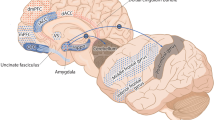The original weight-drop model was employed to examine the effect of mild traumatic brain injury (TBI) on behavioral phenotype and neocortical morphology in rats. The neurological examination of rats with moderate TBI revealed the focal symptoms corresponding to pronounced neurological disorders, whereas in rats after mild TBI, there were only minor coordination disorders. On day 7 after injury, the rats with mild TBI demonstrated enhanced anxiety assessed by conditioned passive avoidance response. The morphometric analysis of the brain tissues revealed narrowing of the capillaries and increased score of hyperchromic neocortical neurons, which attested to cerebral hypoxia. The manifestations of mild TBI in original rat model demonstrated a close similarity to the symptoms of TBI in humans.
Similar content being viewed by others
References
Radkov IV, Plekhova NG, Dyujzen IV, Zinovev SV, Baryshev AN. Patent RU No. 2725287. Method for simulating brain contusion of mild degree. Bull. No. 19. Published June 30, 2020.
Semchenko VV, Stepanov SS, Ereview SI. Structural and functional recovery of the nervous tissue of the brain in the post-ischemic period from the standpoint of view of provisory in reparative histogenesis. Tikhookean. Med. Zh. 2016;(2):98-102. Russian.
Radkov IV, Laptev VV, Plekhova NG. Technologies of modeling the diffuse traumatic brain injury. Sovremen. Probl. Nauki Obrazovaniya. 2018;(4):148. Russian.
Dixon KJ. Pathophysiology of Traumatic Brain Injury. Phys. Med. Rehabil. Clin. N. Am. 2017;28(2):215-225. https://doi.org/10.1016/j.pmr.2016.12.001
Hemphill MA, Dauth S, Yu CJ, Dabiri BE, Parker KK. Traumatic brain injury and the neuronal microenvironment: a potential role for neuropathological mechanotransduction. Neuron. 2015;85(6):1177-11792. https://doi.org/10.1016/j.neuron.2015.02.041
Ma M, Matthews BT, Lampe JW, Meaney DF, Shofer FS, Neumar RW. Immediate short-duration hypothermia provides long-term protection in an in vivo model of traumatic axonal injury. Exp. Neurol. 2009;215(1):119-127. https://doi.org/10.1016/j.expneurol.2008.09.024
McIntosh AS, Patton DA, Fréchède B, Pierré PA, Ferry E, Barthels T. The biomechanics of concussion in unhelmeted football players in Australia: a case-control study. BMJ Open. 2014;4(5):e005078. https://doi.org/10.1136/bmjopen-2014-005078
Mychasiuk R, Farran A, Angoa-Perez M, Briggs D, Kuhn D, Esser MJ. A novel model of mild traumatic brain injury for juvenile rats. J. Vis. Exp. 2014:(94):51820. https://doi.org/10.3791/51820
Narayana PA. White matter changes in patients with mild traumatic brain injury: MRI perspective. Concussion. 2017; 2(2):CNC35. https://doi.org/10.2217/cnc-2016-0028
Ngamdee K, Noipa T, Martwiset S, Tuntulani T, Ngeontae W. Enhancement of sensitivity of glucose sensors from alizarin– boronic acid adducts in aqueous micelles. Sensors and Actuators B: Chemical. 2011;160(1):129-138. https://doi.org/10.1016/j.snb.2011.07.023
Pascual JM, Prieto R. Ch. 133: Surgical management of severe closed head injury in adults operative neurosurgery. Schmidek and Sweet Operative Neurosurgical Technique. Vol. 2. Elsevier, 2012. P. 1513-1538.
Skottnik L, Linden DEJ. Mental Imagery and Brain Regulation- New Links Between Psychotherapy and Neuroscience. Front. Psychiatry. 2019;10:779. https://doi.org/10.3389/fpsyt.2019.00779
Smith DH. Neuromechanics and Pathophysiology of Diffuse Axonal Injury in Concussion. Bridge (Wash DC). 2016;46(1):79-84.
Xiong Y, Mahmood A, Chopp M. Animal models of traumatic brain injury. Nat. Rev. Neurosci. 2013;14(2):128-142. https://doi.org/10.1038/nrn3407
Yamamoto S, Levin HS, Prough DS. Mild, moderate and severe: terminology implications for clinical and experimental traumatic brain injury. Curr. Opin. Neurol. 2018;31(6):672-680. https://doi.org/10.1097/WCO.0000000000000624
Author information
Authors and Affiliations
Corresponding author
Additional information
Translated from Byulleten’ Eksperimental’noi Biologii i Meditsiny, Vol. 170, No. 11, pp. 640-645, November 2020
Rights and permissions
About this article
Cite this article
Plekhova, N.G., Radkov, I.V., Zinoviev, S.V. et al. Effect of Mild Traumatic Brain Injury on Behavioral Reactions and Neocortical Morphology in Rats. Bull Exp Biol Med 170, 672–676 (2021). https://doi.org/10.1007/s10517-021-05130-6
Received:
Published:
Issue Date:
DOI: https://doi.org/10.1007/s10517-021-05130-6




